Crossref Citations
This article has been cited by the following publications. This list is generated based on data provided by
Crossref.
Bradley, Richard
1972.
Prehistorians and pastoralists in Neolithic and Bronze Age England.
World Archaeology,
Vol. 4,
Issue. 2,
p.
192.
Fleming, Andrew
1972.
The genesis of pastoralism in European prehistory.
World Archaeology,
Vol. 4,
Issue. 2,
p.
179.
Green, H. Stephen
1974.
Early Bronze Age Burial, Territory, and Population in Milton Keynes, Buckinghamshire, and the Great Ouse Valley.
Archaeological Journal,
Vol. 131,
Issue. 1,
p.
75.
Drewett, Peter
1979.
New Evidence for the Structure and Function of Middle Bronze Age Round Houses in Sussex.
Archaeological Journal,
Vol. 136,
Issue. 1,
p.
3.
Allen, David
Green, H. Stephen
Healey, Elizabeth
Shepherd, I. A. G.
Bayley, Justine
and
Jones, R. T.
1981.
The Excavation of a Beaker Burial Monument at Ravenstone, Buckinghamshire, in 1978.
Archaeological Journal,
Vol. 138,
Issue. 1,
p.
72.
Bove, Frederick J.
1981.
Trend Surface Analysis and the Lowland Classic Maya Collapse.
American Antiquity,
Vol. 46,
Issue. 1,
p.
93.
Wyllys Andrews V, E.
and
Harrison, Margaret A. L.
1981.
Obituary: Robert Wauchope, 1909-1979.
American Antiquity,
Vol. 46,
Issue. 1,
p.
113.
Pitts, Michael W.
Howard, Hilary
Bartlett, Alister
and
David, Andrew
1982.
On the Road to Stonehenge: Report on Investigations beside the A344 in 1968, 1979 and 1980.
Proceedings of the Prehistoric Society,
Vol. 48,
Issue. 1,
p.
75.
Millett, Martin
and
James, Simon
1983.
Excavations at Cowdery's Down Basingstoke, Hampshire, 1978–81.
Archaeological Journal,
Vol. 140,
Issue. 1,
p.
151.
Bell, Martin
1983.
Valley Sediments as Evidence of Prehistoric Land-use on the South Downs.
Proceedings of the Prehistoric Society,
Vol. 49,
Issue. 1,
p.
119.
FORD, STEPHEN
BRADLEY, RICHARD
HAWKES, JOHN
and
FISHER, PETER
1984.
FLINT‐WORKING IN THE METAL AGE.
Oxford Journal of Archaeology,
Vol. 3,
Issue. 2,
p.
157.
Taylor, Alison F.
Woodward, Peter J.
Rudd, Granville
ApSimon, Arthur P.
Allen, R.
Arthur, J. R. B.
Bradley, Richard
Denston, Bernard
Field, K.
Gardiner, Julie P.
Grant, Annie
Keeley, Helen
Keepax, Carole
and
Taylor, Robin
1985.
A Bronze Age barrow cemetery, and associated settlement at Roxton, Bedfordshire.
Archaeological Journal,
Vol. 142,
Issue. 1,
p.
73.
Faulkner, Neil
1996.
Verulamium: Interpreting Decline.
Archaeological Journal,
Vol. 153,
Issue. 1,
p.
79.
Allen, Michael J.
2005.
Beaker Settlement and Environment on the Chalk Downs of Southern England.
Proceedings of the Prehistoric Society,
Vol. 71,
Issue. ,
p.
219.
Darvill, Timothy
2016.
Houses of the Holy: Architecture and Meaning in the Structure of Stonehenge, Wiltshire, UK.
Time and Mind,
Vol. 9,
Issue. 2,
p.
89.
